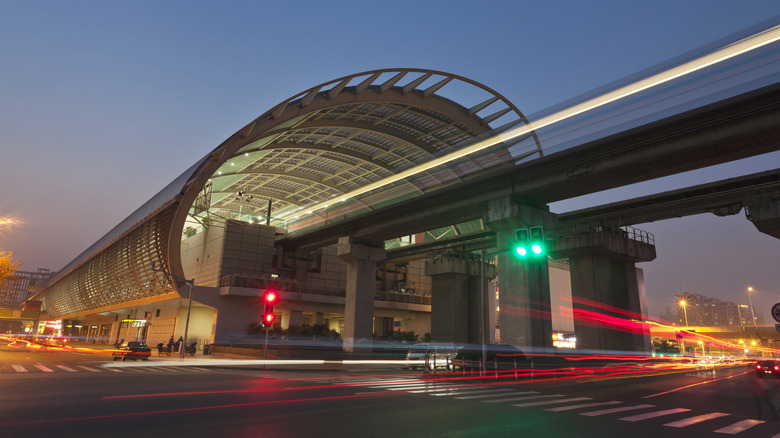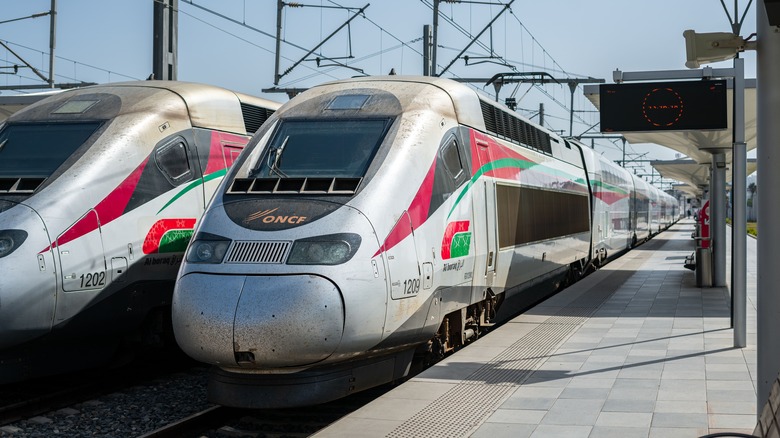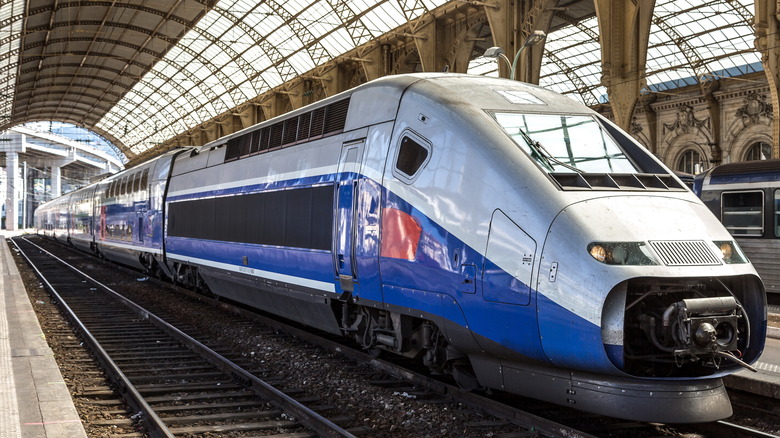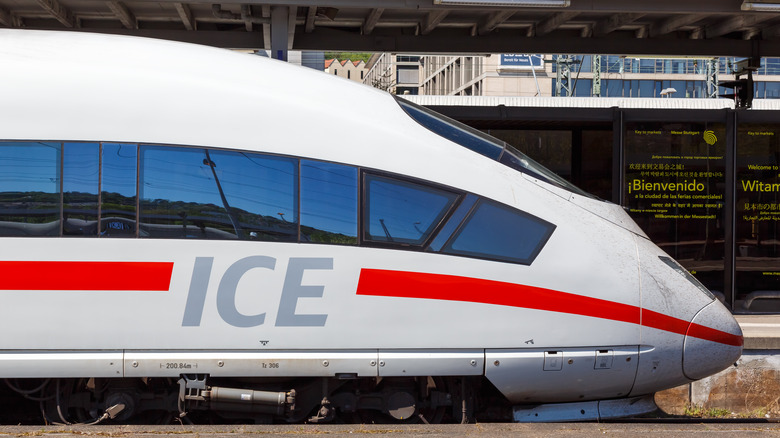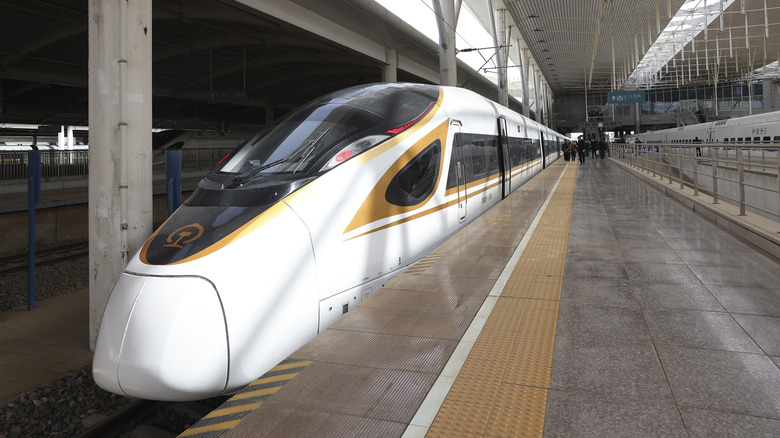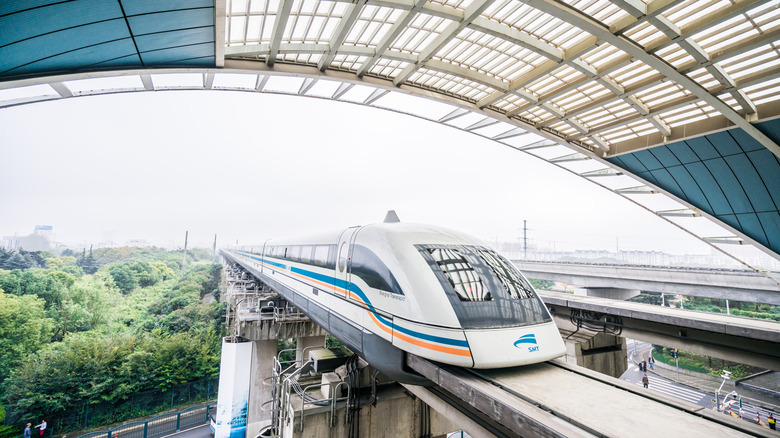5 Of The Fastest Passenger Trains From Around The World
High-speed rail offers a more comfortable and earth-friendly alternative to traveling by air, and there are several places around the world that are pushing the limits for getting you to your destination quickly. In the U.S., where high-speed rail is slowly evolving, you might be better off getting an airplane ticket, but you'll have to face cramped seating and crowded airports. While there are some high-speed lines in the northeast and a plan for a San Francisco to Los Angeles line in California, they are few and far in between. As a result, the fastest trains in the world are all overseas.
While high-speed trains certainly won't replace air travel for long, international trips, they can be an excellent alternative for shorter jaunts. Offering roomier accommodations and spectacular views, it's no wonder high-speed rail has evolved in other countries, and particular lines boast the fastest land travel the world over. Read on to learn about five of the fastest passenger trains from around the world.
Al Boraq - Morocco (198.5mph)
This two-level train travels between popular tourist destinations in Kenitra, Rabat, Tangier, and a soon-to-be-upgraded line to Casablanca. It is currently the only high-speed rail line in Africa, and it blazes over the rails at almost 200 mph. It is just the first phase of a longer high-speed rail line that uses TGV Euroduplex-style trains built in France to whisk passengers between cities.
"Al Boraq," a name fittingly based on a creature from Islamic tradition that carried prophets from Mecca to Jerusalem, now brings passengers between destinations in well under half the time of any other train in Africa. The connection to Casablanca rides on a more upgraded track than others in Africa, but a plan to match the rails between the other cities along the line will cut a once near-five-hour trip down to 90 minutes. The double-decker train offers both first-class and economy-class accommodations, but both are generally more luxurious than flying on most airlines.
TGV - France (200mph)
The speedy TGV trains operate between several cities in France and also take you to cities in other countries in Europe including Spain, Switzerland, Italy, and England, among others. Though the speeds noted in this list are more of an average across lines in their locations, France holds the world record for high-speed rail with the TGV at 357 mph. While it is amazing the train can reach those speeds, most are not trying to set world records while traveling.
As Europe's first high-speed rail system going back to the 1980s, it has evolved both in technology and the number of destinations along its route. One of the great advantages of to traveling Europe by train is that stations are located in the centers of cities, which is what most tourists are trying to visit. It should come as no surprise that, on average, more than 85 million people use France's high-speed rail every year.
CE 3 - Germany (205mph)
ICE 3, also known as the Intercity Express 3, was developed by Siemens and is part of a wider family of trains that run all across Europe. The power behind this train set comes from 16 different electric motors arranged throughout the 8-cars, providing up to a whopping 11,000 horsepower. Variations of the ICE 3 run all over that part of the globe, with trains spanning several countries including the United Kingdom, Belgium, France, the Netherlands, China, and Russia, among others.
ICE 3 trains usually run at the national speed limit of 205mph, but they have one notable exception. On one particular line in Germany between Cologne and Frankfurt, speeds are allowed to top out at over 210mph if the train is running late. This 110-mile passage, which used to take two and a half hours in riding time on older trains, can now be traversed in just over an hour using the most upgraded versions of the ICE 3.
CR400 Fuxing - China (217mph)
China has a vast network of rail lines boasting the largest network of high-speed rails in the world. The "Fuxing" line of trains is completely domestically built. This sets it apart from popular high-speed train models from Germany and France, which run in many countries around the globe. While it is built domestically, China's technology was based on trains from both France and Japan.
These trains, which are well known for the Beijing-to-Shanghai high-speed railway, can get you from one to the other in just under five hours. For comparison, if you were able to maintain a speed of 70 mph in a car, it would take you almost 11 hours to make the same trek. The trains can be up to 16 cars long and feature accommodations akin to higher end commercial jets like touchscreen entertainment and device charging capabilities, all with more room for you to stretch out and enjoy the ride. It also has the distinction of being the only autonomous train in the world, but only on a few routes throughout the country.
Shanghai Maglev - China (286mph)
If you really want to blast through the countryside at top speed, China's Maglev trains are leaps and bounds beyond other high-speed rail systems. Opting for a magnetic levitation system (Maglev), these trains take away all the friction caused by more conventional trains on rails. They operate on an elevated track and have the distinction of being the only Maglev trains used in the world for commercial passenger travel.
The Shanghai Maglev runs between Longyang Road Station in Shanghai and the Shanghai Pudong International Airport. It's an approximately 19-mile distance between the two, which the Maglev can do in just under eight minutes. Though it is a one-of-kind system currently, China has plans to expand Maglev trains for use across the country with updated trains that will run even faster. What's truly amazing is that this technology was put in over 10 years ago, but still easily beats out the competition for high-speed rail.
